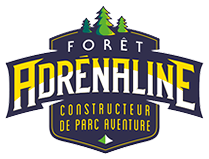Forêt Adrénaline Construction shares its advice for forest maintenance in adventure parks.
Caring for trees is essential to ensure their long-term health and the sustainability of the park. Here are some specific tips to protect roots, minimize the impact of trampling, and maintain a healthy forest environment.
Protecting tree roots
Roots are vital for stability, nutrition, and the overall health of trees. Damage to roots can weaken trees, making them more vulnerable to disease, pests, and falling, which compromises the safety of the park. There are several preventive solutions to protect roots and care for trees.
Actions to implement:
- Radial protection zone: Install barriers around the base of trees to prevent visitors from walking directly on the roots, keeping a distance equal to three times the trunk’s diameter.
- Path design: Use raised walkways, wooden planks, or bridges to guide visitors and reduce pressure on roots in the park’s busiest areas.
- Mulching: Apply organic mulch around trees to reduce soil compaction and maintain the moisture needed for root health.
- Regular inspections: Frequently check the roots and soil to quickly detect any signs of damage.
- Visitor education: Raise visitor awareness of the importance of preserving roots by avoiding walking near the base of trees.

Limiting the impact of visitor trampling
Constant trampling compacts the soil, reducing aeration and water absorption, which disrupts root hydration and weakens tree stability—directly impacting safety.
Actions to implement:
- Regular inspections: Have trees checked by professionals to detect issues early.
- Defined routes: Create marked paths to reduce pressure on sensitive areas.
- Visitor guidance: Use signs to direct people to designated trails.
- Protect fragile zones: Use natural or artificial barriers to safeguard soils.
- Soil refilling: In sensitive areas, add 5–10 cm of soil around tree bases (without burying the collar) to protect roots, improve soil structure, and boost nutrients.
Maintaining a Healthy Forest Environment
Why is it essential?
A healthy forest is key to the sustainability of adventure parks. Strong trees ensure visitor safety, enhance the overall experience, and preserve the site’s beauty and biodiversity. Forest resilience depends on the natural cycle of roots, branches, and leaves decomposing to enrich the soil with vital nutrients. Sustainable management means protecting this cycle, fostering species diversity, and supporting complex ecosystems.
Actions to implement:
- Biodiversity conservation: Plant native species, create habitats for local wildlife, and monitor flora and fauna to adapt practices accordingly.
- Waste management: Properly dispose of waste to prevent pests and disease, and encourage composting.
- Sustainable materials: Use eco-friendly construction and landscaping materials.
- Rainwater management: Reduce soil erosion and ensure proper water infiltration.
- Lower carbon footprint: Promote sustainable transport and reduce on-site energy use.
Conclusion
Protecting roots, managing soils carefully, and preserving forest ecosystems are crucial for tree health in adventure parks. By adopting these practices, operators can safeguard their forests while offering visitors a safer, richer experience.
👉 Forêt Adrénaline Construction is available to provide further guidance. Together, we can build sustainable, nature-friendly spaces for adventure lovers.
